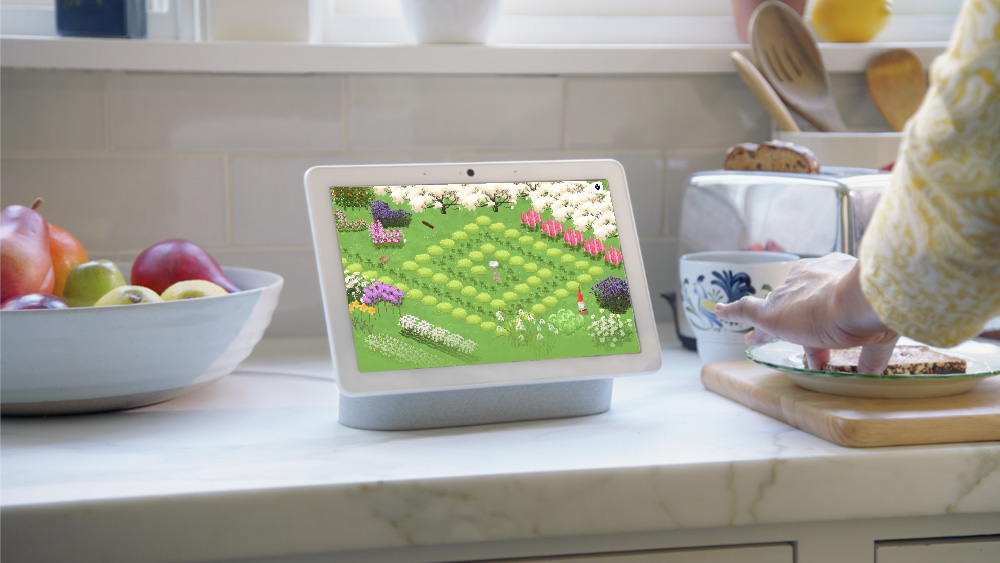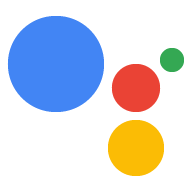作为增长最快的家居设备之一,智能显示屏是一种新的游戏平台。带有显示屏的 Google 助理设备提供了绝佳机会,通过丰富的视觉效果和游戏来娱乐玩家。
了解为何以及如何针对智能显示屏进行构建,以及如何将游戏扩展到更多设备。
专为智能显示屏设计
智能显示屏创造了一个新的游戏空间:在厨房操作台上、沙发旁边或家庭房中。这些设备坐在人流量大、多人共用的区域,几乎可以在任何地方供家里的任何人使用。只需简单操作,即可让多人快速访问您的游戏。

智能显示屏设备周围的游戏空间与其他游戏平台不同。多人可能同处一室,非游戏活动也可能会同时进行。这种环境为构建游戏带来了一些独特的挑战和机遇:
- 距离较远的互动:玩家可能会四处移动,距离设备几步之遥与设备对话,并且在与设备互动时没有看显示屏。有鉴于此,您的游戏应完全可以通过语音互动玩,避免玩家依赖于需要触摸屏幕的操作。您还应设计游戏视觉效果,让远处的玩家能够看清游戏内容。
- 多个玩家同时输入:智能显示屏非常适合涉及多人的游戏,因此请考虑如何一次与多个玩家互动。考虑到这一点,请确保同一台设备上的多人可以轻松欣赏游戏的图形。
- 公共公共空间:智能显示屏通常位于客流量高的地方,例如客厅和厨房。考虑您的游戏如何与游戏过程中发生的其他活动(例如烹饪、清洁、家庭作业或友好辩论)混合或结合。
如需详细了解创建有效语音界面的原则,请访问对话设计网站。您还可以查看 Android 的面向 TV 的设计原则,其中就如何设计远距离的玩家互动提供了类似且有用的建议。
在技术方面,Google 助理开发者平台提供了 Interactive Canvas 框架,以使用熟悉的网页开发工具为智能显示屏构建游戏。借助此框架,您可以打造全屏视觉和对话体验。如需详细了解如何使用 Interactive Canvas 进行构建,请参阅开发者文档。
通过语音构建视觉游戏
从早期的游戏机到现代手游,玩家都期待从游戏中获得出色的视觉体验。智能显示屏提供了一种为玩家打造这种体验的方式,并以新的维度(即语音)吸引玩家。
 智能显示屏让用户感到熟悉的大型触摸屏,搭配语音界面的速度,在从现有游戏到支持语音的游戏体验之间架起了一座桥梁。玩家只需说“Hey Google,我们玩游戏吧”,即可快速进入游戏。如果用户进入不熟悉的地方,屏幕会提供一个额外的舒适输入选项。
智能显示屏让用户感到熟悉的大型触摸屏,搭配语音界面的速度,在从现有游戏到支持语音的游戏体验之间架起了一座桥梁。玩家只需说“Hey Google,我们玩游戏吧”,即可快速进入游戏。如果用户进入不熟悉的地方,屏幕会提供一个额外的舒适输入选项。
针对 Google 助理生态系统中同时具有显示功能和语音界面的设备提供两种与玩家互动、娱乐和协助的方式,让您的游戏创造绝佳的成功机会。
将覆盖范围扩展到更多设备
Google 助理不仅可在智能显示屏上运行,虽然您应该首先针对智能显示屏进行设计,但也要注意可以玩您的游戏的其他支持 Google 助理的设备。特别是,智能手机在设备用户中占据了很大一部分,并且智能音箱的使用量也在不断增长。
适应智能手机
若要针对智能手机优化 Google 助理游戏,请执行以下操作:
- 使用自适应设计:使用自适应设计技术根据不同的屏幕尺寸进行调整,尤其是对于较小的手机屏幕。Google 助理使用 HTML 技术来实现视觉呈现,因此您可以将自己熟悉的大部分自适应设计用于游戏。
- 考虑到音量的因素:由于智能手机经常会用到,因此玩家经常会调低或关闭音量。最好提醒玩家在游戏开始时检查音量,但由于他们所处的位置(例如安静的聚会或嘈杂的通勤),他们可能无法使用声音。请务必在您的设计中考虑到这一点,具体做法是,让您的游戏除了支持语音之外还能够通过轻触进行导航,并确保音频提示中包含的重要信息在屏幕上也能读出。
适应智能音箱
随着您的玩家群体越来越熟悉您的游戏,有经验的玩家可能会想要使用纯语音界面,而且这种界面可以让新玩家更轻松地上手您的游戏。
考虑如何通过将游戏内容缩容到受限模式或切换到信息模式,在纯音频模式下运行您的游戏。例如,如果玩家通过纯语音设备激活您的游戏,您可以提供关于游戏功能、新闻、任务更新或排行榜状态的更新信息。
如需详细了解如何为扬声器设计纯语音交互,请参阅对话设计网站。

